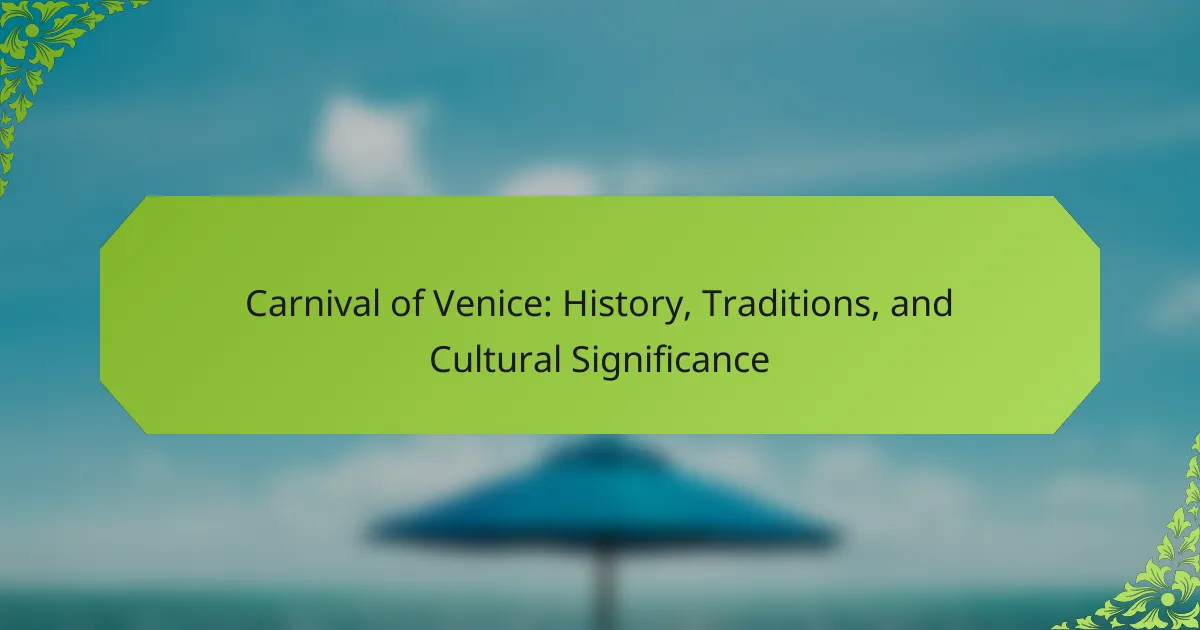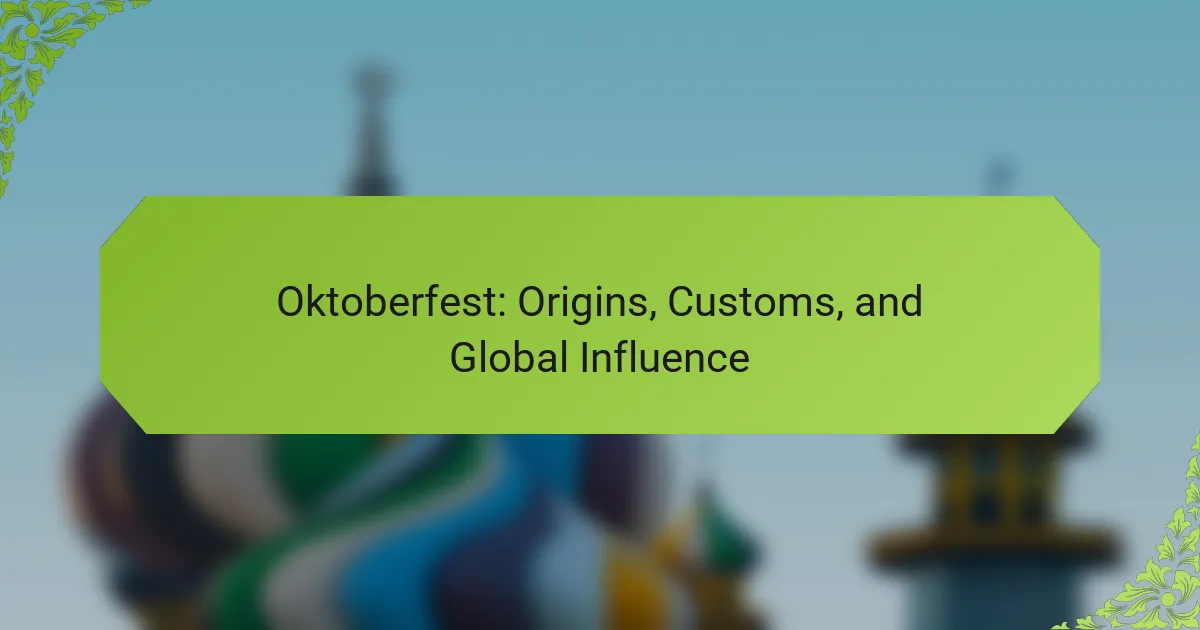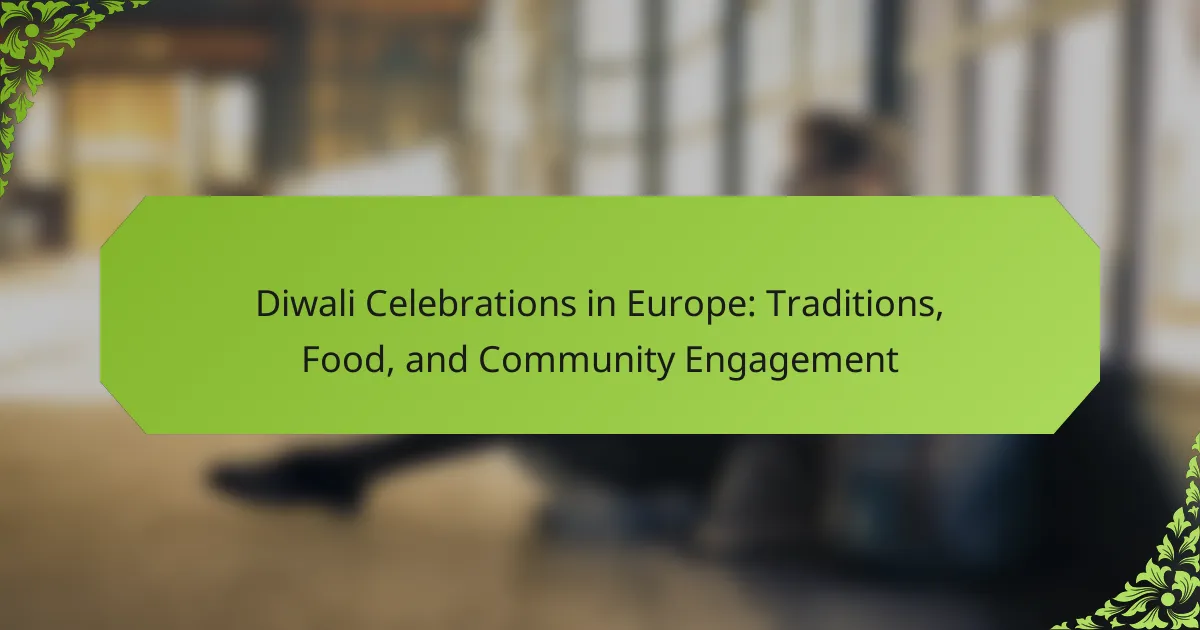The Carnival of Venice is a vibrant celebration rich in history and cultural significance. Originating in the 12th century, it features elaborate masks and costumes, symbolizing social equality. Key traditions include grand balls and historical parades, showcasing Venice’s artistic heritage. However, the festival faces challenges like commercialization and environmental concerns, impacting its traditional essence.
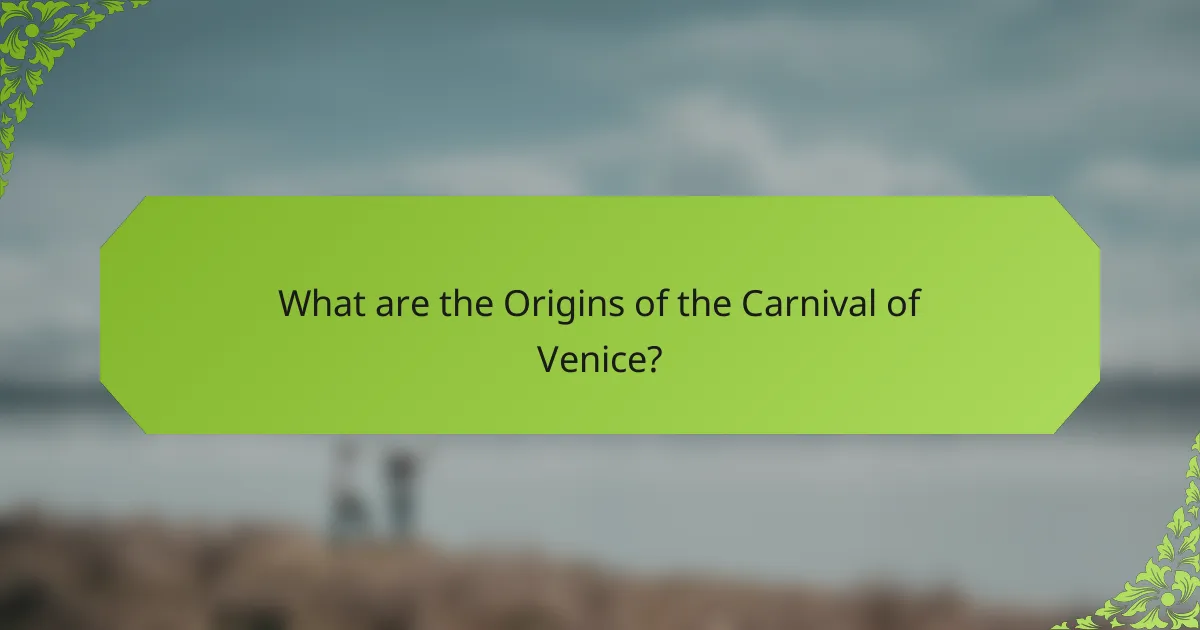
What are the Origins of the Carnival of Venice?
The Carnival of Venice originated in the 12th century, initially linked to the celebration of the victory over the Patriarch of Aquileia. It evolved into a grand festival known for its elaborate masks and costumes, symbolizing freedom and social equality. Over the centuries, the event became a significant cultural expression, blending traditions, arts, and local customs. The unique attribute of the Carnival is its iconic masks, which allow participants to transcend social classes and engage anonymously in the festivities. The celebration was officially suppressed in the 18th century but was revived in the late 20th century, becoming a major tourist attraction and cultural heritage event.
How has the Carnival evolved through the centuries?
The Carnival of Venice has evolved significantly since its origins in the 11th century. Initially, it served as a time for the lower classes to enjoy festivities alongside the nobility, promoting social unity. Over the centuries, the Carnival has embraced elaborate masks and costumes, symbolizing anonymity and freedom.
In the 18th century, the event reached its peak with grand balls and public celebrations, showcasing the city’s artistic heritage. The decline in the 19th century led to a near disappearance, but a revival in the late 20th century restored its cultural significance. Today, the Carnival is recognized for its rich traditions, including the famous “Mascherade” and “Volo dell’Angelo,” attracting millions from around the world.
Which historical events shaped the Carnival’s identity?
The Carnival of Venice’s identity was shaped by various historical events, including the establishment of trade routes and the influence of the Byzantine Empire. The festival evolved during the Renaissance, reflecting cultural exchanges and artistic expressions. The 18th century marked a peak, with elaborate masks and costumes symbolizing social status and anonymity. The decline in the 19th century led to a revival in the late 20th century, emphasizing heritage and tourism. Each phase contributed unique attributes to the Carnival’s cultural significance and traditions.

What are the Key Traditions of the Carnival of Venice?
The key traditions of the Carnival of Venice include elaborate masks, grand balls, and historical parades. Masks symbolize anonymity and social equality, allowing people to engage freely. The tradition of wearing masks dates back to the 13th century, highlighting the festival’s deep historical roots. Grand balls held in historic palaces showcase opulence and creativity, attracting visitors from around the world. Additionally, the “Volo dell’Angelo,” a symbolic flight from the Campanile, marks the carnival’s opening, emphasizing the event’s theatrical nature. These traditions collectively enhance the cultural significance of the Carnival, celebrating Venetian heritage.
How do masks symbolize the Carnival experience?
Masks symbolize the Carnival experience by allowing individuals to express freedom and anonymity. This tradition dates back centuries, enabling social interaction beyond societal norms. Masks foster creativity, showcasing intricate designs and colors, which enhance the festive atmosphere. They serve as a bridge between reality and fantasy, inviting participants to immerse themselves in the celebration. The unique attributes of Venetian masks, such as their craftsmanship and historical significance, further enrich the Carnival’s cultural landscape.
What roles do music and dance play in the festivities?
Music and dance are central to the Carnival of Venice, enhancing its vibrant atmosphere and cultural expression. They serve as vital elements in the festivities, fostering community spirit and artistic creativity. Traditional Venetian music, often featuring live bands and orchestras, sets the tone for celebrations. Dance performances, including historical reenactments, engage participants and spectators alike, creating a sense of connection to Venice’s rich heritage. Together, music and dance embody the essence of Carnival, celebrating freedom and joy through artistic expression.
Which unique rituals are exclusive to the Carnival?
The Carnival of Venice features unique rituals such as the traditional “Volo dell’Angelo,” where a performer descends from the Campanile. Another exclusive ritual is the “Mascherata,” emphasizing elaborate masks and costumes. The “Festa delle Marie” celebrates the historical abduction of twelve brides, showcasing vibrant parades. Each ritual highlights the Carnival’s deep cultural significance and historical roots.
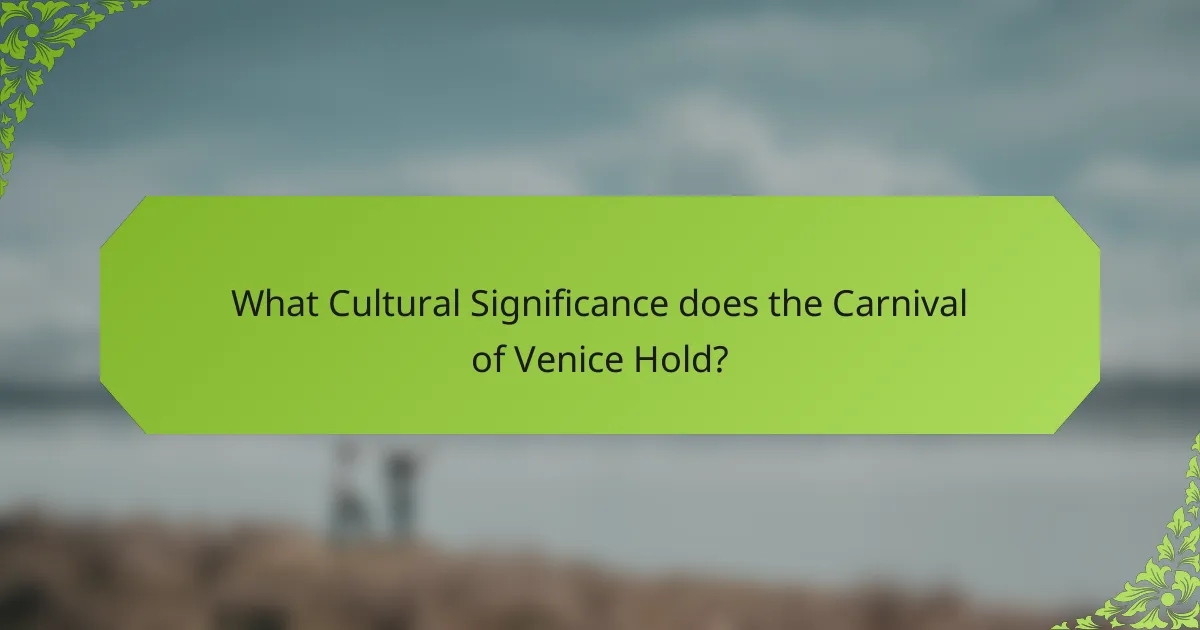
What Cultural Significance does the Carnival of Venice Hold?
The Carnival of Venice holds immense cultural significance as a celebration of art, history, and community. Originating in the 12th century, it showcases Venetian traditions through elaborate costumes and masks. The masks symbolize anonymity, allowing social barriers to dissolve and fostering equality among participants. This festival also preserves local customs and crafts, contributing to Venice’s cultural identity. As a result, the Carnival attracts global visitors, enhancing cultural exchange and appreciation for Venetian heritage.
How does the Carnival reflect Venetian identity and heritage?
The Carnival of Venice embodies Venetian identity and heritage through its rich traditions and historical significance. This festival showcases the city’s unique culture, emphasizing creativity and artistry. The elaborate masks symbolize anonymity, allowing freedom of expression, which reflects the city’s spirit of inclusivity. Additionally, the Carnival’s origins in the 12th century connect it to Venice’s historical trade routes and multicultural influences. Each year, the event attracts visitors globally, reinforcing Venice’s status as a cultural hub. The vibrant parades and performances celebrate local customs, preserving the city’s traditions for future generations.
What impact does the Carnival have on local economy and tourism?
The Carnival of Venice significantly boosts the local economy and tourism. It attracts over three million visitors annually, generating substantial revenue for hotels, restaurants, and local businesses. The festival’s cultural significance enhances the city’s appeal, promoting year-round tourism. Additionally, the Carnival fosters job creation in various sectors, including hospitality and entertainment. As a result, local artisans and performers gain visibility, contributing to a vibrant cultural economy.

What are the Unique Features of the Carnival of Venice?
The unique features of the Carnival of Venice include elaborate masks, historical costumes, and traditional events. Masks allow participants to conceal their identities, fostering a sense of mystery. The festival showcases a rich array of historical costumes, reflecting Venice’s artistic heritage. Events like the Flight of the Angel and the Grand Ball highlight the carnival’s cultural significance and vibrant atmosphere. Each aspect contributes to the festival’s allure, making it a distinct celebration in the world of cultural events.
How do contemporary interpretations differ from traditional practices?
Contemporary interpretations of the Carnival of Venice emphasize inclusivity and modern artistic expressions, differing from traditional practices focused on historical authenticity and rigid customs. Modern celebrations often incorporate diverse cultural influences and interactive experiences, attracting a broader audience. Traditional practices prioritize elaborate costumes and masks, reflecting Venice’s rich history. As a result, the contemporary carnival showcases a blend of innovation and heritage, creating a dynamic cultural event.
What are the most iconic events during the Carnival?
The most iconic events during the Carnival of Venice include the Grand Parade, the Flight of the Angel, and the Masked Balls. These events showcase the rich history and vibrant traditions of the celebration.
The Grand Parade features elaborate floats and costumes, attracting thousands of spectators. The Flight of the Angel is a thrilling aerial display where a performer descends from the Campanile, symbolizing the start of the festivities. Masked Balls, held in historic palaces, offer an immersive experience of Venetian culture and elegance.
Each event highlights unique aspects of the Carnival, drawing on centuries of tradition and artistic expression. The combination of music, dance, and theatrical performances creates an unforgettable atmosphere.
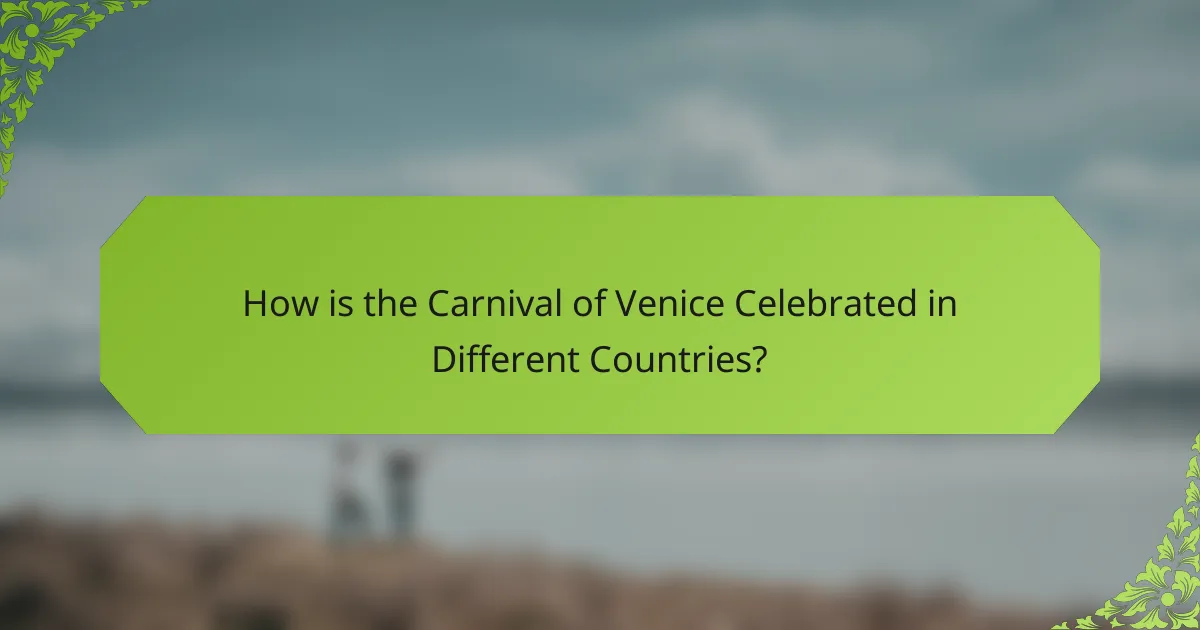
How is the Carnival of Venice Celebrated in Different Countries?
The Carnival of Venice is celebrated globally with unique local traditions and festivities. Countries like Brazil and Trinidad incorporate vibrant parades and music, reflecting their cultural heritage. In France, similar masquerade balls emphasize elegance and historical themes. Each celebration connects to the Venetian roots through masks and costumes, showcasing the universal appeal of carnival spirit.
What similarities and differences exist in global Carnival celebrations?
Carnival celebrations globally share vibrant festivities but vary in traditions and cultural significance. The Carnival of Venice, known for its elaborate masks and historical roots, emphasizes artistic expression and social commentary. In contrast, Brazil’s Carnival features samba parades and street parties, highlighting cultural diversity and community spirit. Both events promote joy and unity but differ in their expressions of heritage and local customs.
How do local cultures influence the interpretation of the Carnival?
Local cultures significantly shape the interpretation of the Carnival, influencing customs, attire, and festivities. The Carnival of Venice, with its rich history, showcases unique cultural expressions through elaborate masks and costumes, reflecting local artistry and traditions. Each year, local communities infuse their heritage into the celebrations, creating a diverse tapestry of performances and events. This cultural significance is rooted in Venice’s historical position as a melting pot of influences, enhancing the Carnival’s appeal and meaning across different cultures.
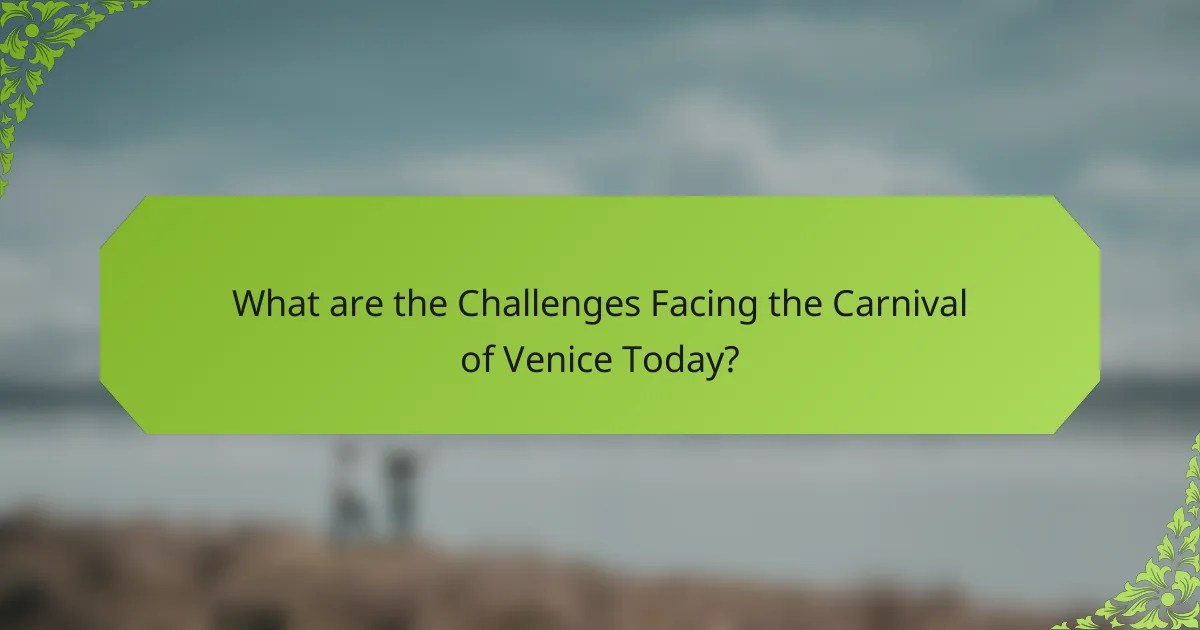
What are the Challenges Facing the Carnival of Venice Today?
The Carnival of Venice faces challenges such as commercialization, environmental concerns, and cultural dilution. These issues threaten its traditional essence and sustainability. The increasing number of tourists leads to overcrowding, impacting the local community and heritage. Additionally, the need for modern safety measures can clash with historical practices, creating tension between preservation and innovation.
How is climate change affecting the Carnival’s sustainability?
Climate change significantly impacts the Carnival of Venice’s sustainability. Rising sea levels threaten the historic city, increasing flooding risks during the festival. Additionally, changing weather patterns can disrupt traditional celebrations and reduce visitor attendance. The Carnival’s reliance on elaborate costumes and decorations also faces challenges as materials become less sustainable. Efforts to promote eco-friendly practices are essential for preserving this cultural event.
What measures are being taken to preserve the Carnival’s traditions?
The Carnival of Venice preserves its traditions through various measures. These include the promotion of historical costumes, workshops for mask-making, and the organization of traditional events such as parades and competitions. Local organizations collaborate with cultural institutions to ensure the authenticity of performances and activities. Educational programs engage the community and visitors, highlighting the significance of Venetian heritage. Additionally, regulations protect traditional crafts and practices, ensuring their continuity for future generations.

What are the Best Practices for Attending the Carnival of Venice?
To fully enjoy the Carnival of Venice, plan your visit around key events, dress in traditional attire, and immerse yourself in the local culture. Arrive early to secure prime viewing spots for parades and performances.
1. Research the event schedule to prioritize must-see activities.
2. Wear a mask or costume to enhance the experience and blend in.
3. Explore various neighborhoods for diverse festivities.
4. Engage with locals to understand the traditions and history.
5. Taste local cuisine to appreciate Venetian culinary arts.
6. Be mindful of crowds and plan for transportation.
How can visitors fully immerse themselves in the Carnival experience?
Visitors can fully immerse themselves in the Carnival experience by participating in traditional events and engaging with the vibrant atmosphere. Attending parades showcases elaborate costumes and masks, which are integral to the Carnival’s cultural significance. Exploring local cuisine enhances the experience, with specialties like fritelle and galani available throughout the celebration.
Joining workshops allows visitors to learn about mask-making and historical performances, deepening their understanding of Venice’s rich heritage. Finally, staying in the city during the festivities provides opportunities to enjoy the unique ambiance and interact with locals, making the experience truly memorable.
What common mistakes should attendees avoid?
Attendees should avoid common mistakes like neglecting to plan their costumes, missing key events, and underestimating the crowds. Proper preparation enhances the Carnival of Venice experience.
1. Failing to research the schedule can lead to missing parades and performances.
2. Overpacking costumes may hinder mobility during festivities.
3. Ignoring weather conditions can result in discomfort.
4. Skipping local customs may lead to cultural misunderstandings.
5. Arriving late can mean missing out on popular attractions.
6. Not staying hydrated can diminish enjoyment throughout the event.
